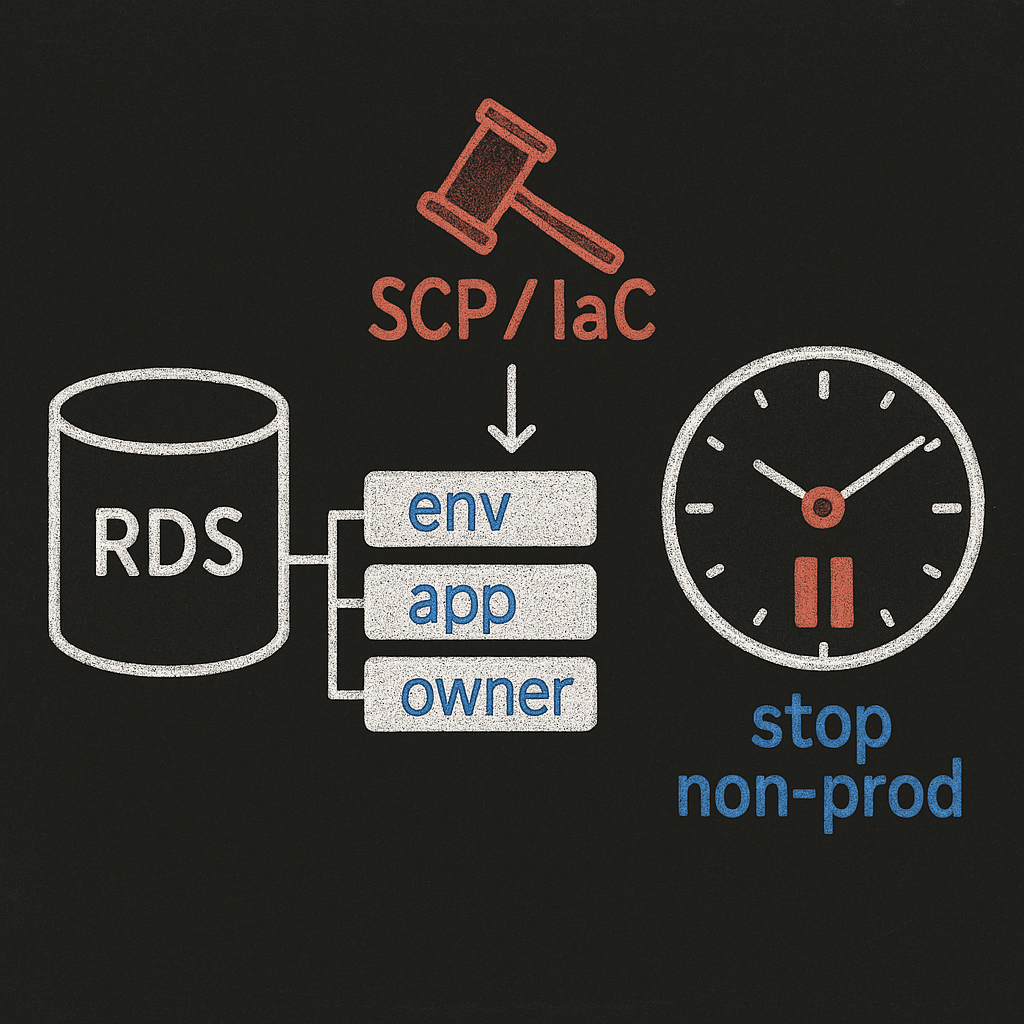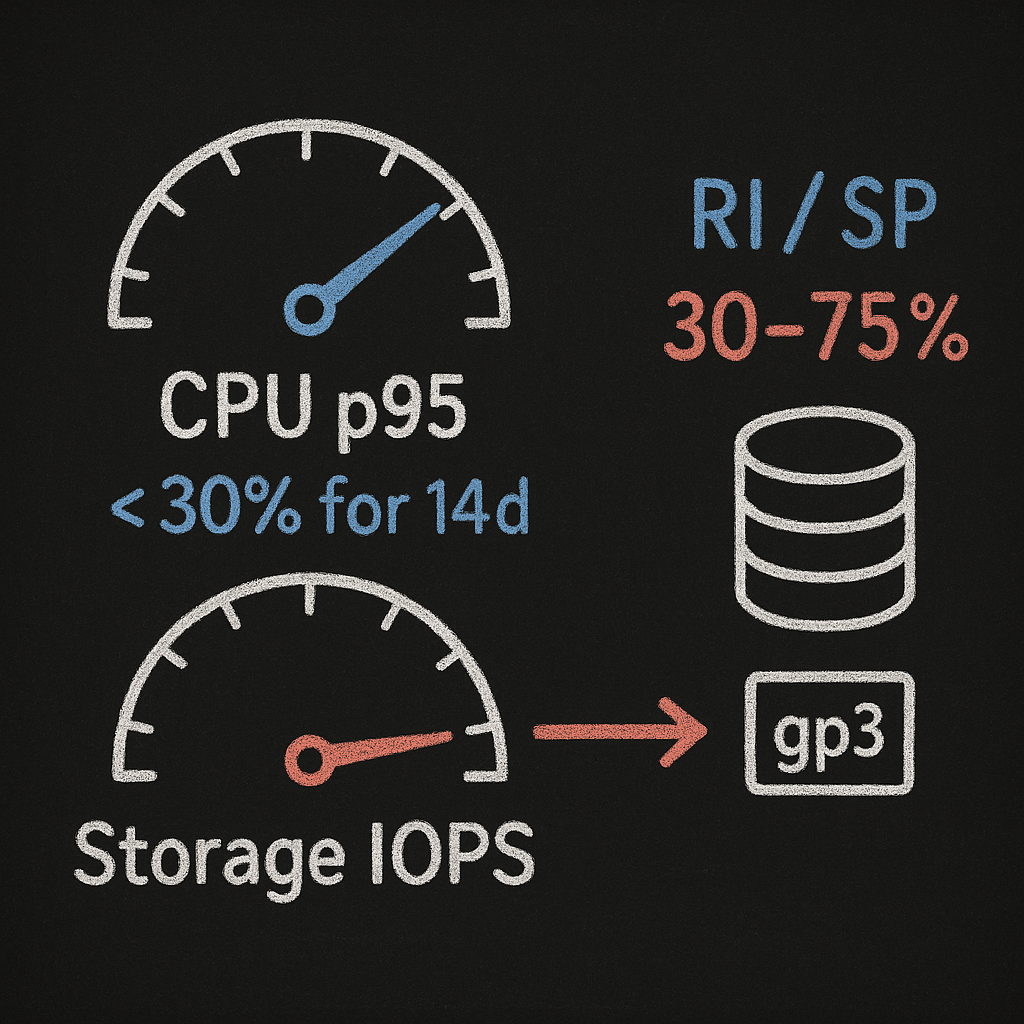Automate AWS RDS cost optimization: 12 proven plays your team can ship this quarter
Are you still hunting for RDS savings by hand? With the right automations, you can claw back 30–40% of spend without touching performance—or your engineers’ nights and weekends.
1) Tag everything, then enforce policy-driven cleanup
Tags are the foundation for automated savings. Standardize a schema (env, app, owner, cost-center, compliance) and enforce it with provisioning guardrails so you can target RDS actions by business context.
Amazon RDS tags create custom references for applications, projects, or departments, enabling CloudWatch monitoring for business insights and expense grouping for informed cost optimization decisions. Tags enable accurate chargeback and policy-driven automations for scheduling, RI coverage, and cleanup.
Block untagged RDS creation via Service Control Policies and IaC validations. Use AWS Config Conformance Packs to detect missing tags and non-compliant retention policies. Then auto-delete dev/test snapshots older than N days by tag to prevent storage bloat.

2) Rightsize RDS instances and storage with metrics-driven changes
Over-provisioning is the most common RDS waste pattern. Drive rightsizing with utilization data (CPU credits, vCPU, connections, read/write IOPS, buffer cache hit ratio) and apply safe change windows.
Pull CloudWatch metrics and set policies (e.g., downsize when p95 CPU < 30% and freeable memory > 40% for 14 days). Enforce gp3 upgrades and provisioned IOPS right-sizing for storage. Implement maintenance windows to apply instance family/size changes safely.

Organizations routinely waste ~35% of spend on low-value resources; systematic rightsizing is a core lever to reclaim this waste through automated cloud cost governance. Storage optimizations alone can cut 20–30% when moving to gp3 and right-sizing IOPS using proven cloud optimization techniques.
3) Turn on Graviton where supported
For MySQL, PostgreSQL, and MariaDB engines, Graviton delivers superior price-performance over x86 families. Build an automation to recommend or migrate eligible instances during maintenance windows.
Graviton-backed RDS commonly improves price/performance for open-source engines, with limitations only for MS SQL and Oracle engines but full compatibility with PostgreSQL, MySQL, and MariaDB. The price-performance advantage makes this a high-priority automation for any environment with supported engines.
4) Automate Reserved Instances and Savings Plans coverage
RDS Reserved Instances and Savings Plans can shave 30–75% off steady usage, but only if you keep coverage and terms continuously optimized as patterns shift.
Use programmatic analysis of 30–90 days of normalized RDS usage. Buy incrementally, rebalance across families/regions, and continuously adjust commitments. Leverage Trusted Advisor and Cost Optimization Hub signals for purchase candidates, then auto-execute after guardrail checks.
RIs provide 30–75% savings compared to on-demand pricing; Savings Plans offer up to 72% with flexible commitments across services and regions. Most organizations are surprised to find they’re achieving less than 25% of their potential savings from automated reserved instance management without proper automation.
5) Schedule non-production RDS to stop outside business hours
Dev/stage/training databases don’t need 24/7 uptime. Cut the clock.
Tag non-prod DBs (env=dev|stage). Use Instance Scheduler on AWS or EventBridge + Lambda to stop at night/weekends and start in the morning. Machine learning-based scheduling solutions can learn environment patterns and automatically cut costs without disrupting workflows for non-production databases.
Automatically turning off non-production environments during nights and weekends can reduce costs for development and testing environments by up to 65% with zero impact on productivity.
Minimal Lambda example (Python) to stop tagged DBs nightly:
import boto3, osrds = boto3.client('rds')TAG_KEY = os.getenv('TAG_KEY', 'env')TAG_VALUE = os.getenv('TAG_VALUE', 'dev')
def lambda_handler(event, context): paginator = rds.get_paginator('describe_db_instances') for page in paginator.paginate(): for db in page['DBInstances']: arn = db['DBInstanceArn'] tags = rds.list_tags_for_resource(ResourceName=arn)['TagList'] if any(t['Key']==TAG_KEY and t['Value']==TAG_VALUE for t in tags): if db['DBInstanceStatus'] == 'available': print(f"Stopping {db['DBInstanceIdentifier']}") rds.stop_db_instance(DBInstanceIdentifier=db['DBInstanceIdentifier'])Trigger with an EventBridge schedule rule (e.g., cron(0 1 ? * MON-FRI *)).
6) Apply snapshot lifecycle and ruthless cleanup
Snapshots are cheap—until they aren’t. Manual and automated snapshots persist until you delete them.
Standardize retention by tag (prod=35 days, non-prod=7). Auto-delete snapshots after retention and purge snapshots for terminated DBs. Move long-term copies to cheaper backup tiers via AWS Backup.
RDS snapshots persist until manually deleted, costing $0.095 per GB per month, making regular cleanup of old backups and redundant automated snapshots essential for cost control. A media company saved 80% on storage costs by implementing automated storage tiering policies that moved infrequently accessed data to lower-cost tiers.
Sample AWS Backup lifecycle (JSON excerpt):
{ "Rules": [{ "RuleName": "rds-prod-35d", "TargetBackupVaultName": "rds-prod", "ScheduleExpression": "cron(0 6 * * ? *)", "StartWindowMinutes": 60, "CompletionWindowMinutes": 180, "RecoveryPointTags": {"env":"prod"}, "Lifecycle": {"DeleteAfterDays": 35}, "CopyActions": [] }]}7) Use AWS Trusted Advisor and the Cost Optimization Hub as guardrails
Treat AWS-native checks as your autopilot copilot.
Poll Trusted Advisor cost checks and RI recommendations and open tickets automatically when potential savings exceed your threshold. Track RI coverage drift weekly and trigger actions.
AWS Trusted Advisor automatically checks Amazon RDS usage patterns and provides Reserved Instance purchase recommendations, with results refreshed several times daily through integration with AWS Cost Optimization Hub. AWS offers multiple tools for RDS cost optimization including AWS Cost Explorer, Amazon CloudWatch, AWS Trusted Advisor, Instance Scheduler on AWS, AWS Backup, and Cloud Intelligence Dashboards in Amazon QuickSight.
8) Optimize reads to reduce instance size pressure
If reads throttle your instance, fix the IO path before scaling up.
Enable RDS Optimized Reads (supported engines/instances) to cut IO bottlenecks. Use read replicas and query routing for bursty read traffic.
Amazon RDS Optimized Reads, introduced in 2022, can provide up to 2x faster query processing by leveraging instance store for improved I/O performance. This often lets you stay on a smaller instance class and avoid a costly step-up in size.
9) Consider Aurora Serverless v2 or stop/start for spiky/rarely used workloads
Not all databases need to be “always on.”
For sporadic usage, evaluate Aurora Serverless v2 for granular autoscaling or orchestrate stop/start windows for standard RDS. Use tags to exclude mission-critical workloads.
For rarely used databases, switching to Aurora Serverless or RDS on-demand stop/start allows pausing and resuming instances as needed instead of paying for constant uptime. This approach is particularly valuable for classroom/lab environments or systems with highly variable usage patterns.
10) Build CloudWatch-driven alerts and budgets that engineers respect
Alert on the signal, not the noise.
Set up cost anomaly detection by tag/app and budget alerts routed to Slack/Jira. Create workload SLO-aware alarms (e.g., p95 latency + freeable memory + CPU) to catch inefficiencies before auto-scaling kicks in. Visualize cost and performance together using Datadog or Grafana; here’s our take on grafana vs datadog pricing if you’re weighing different monitoring options.
Tiny example CloudWatch metric alarm (CPU):
{ "AlarmName": "rds-prod-cpu-high", "MetricName": "CPUUtilization", "Namespace": "AWS/RDS", "Statistic": "Average", "Period": 300, "EvaluationPeriods": 3, "Threshold": 75, "ComparisonOperator": "GreaterThanThreshold", "Dimensions": [{"Name":"DBInstanceIdentifier","Value":"prod-db-1"}], "AlarmActions": ["arn:aws:sns:us-east-1:123456789012:ops-alerts"]}11) Use Cloud Intelligence Dashboards and Cost Explorer for line-of-business visibility
Engineers fix what leaders can see.
Deploy Cloud Intelligence Dashboards in QuickSight for tag-based views across apps/teams. Create weekly reports on RI coverage, idle DBs, and snapshot growth to owners.
Cost optimization requires continuous monitoring of resource utilization metrics to gain insights into RDS usage patterns and identify cost-saving opportunities through data-driven decision-making. Cost optimization is an ongoing process requiring regular review and adjustment as workloads evolve and new features become available, necessitating continual refinement of strategies.
12) Make rate optimization a continuous, automated discipline
Treat discounting like a portfolio that rebalances itself.
Implement ongoing coverage optimization for RIs/Savings Plans with incremental commitments. Create guardrails to prevent overcommitment by analyzing normalized usage and growth trends before purchasing. Where overcommitted, evaluate marketplace options to unwind positions.
Unused Reserved Instances can often be listed for sale on the Amazon Marketplace, providing options to recover costs from overcommitted capacity. AWS Cost Explorer or FinOps tools should analyze past usage before committing to Reserved Instances to avoid overcommitting and paying for unused capacity.
Savings Plans provide up to 72% savings compared to on-demand pricing with flexible commitments across services and regions, while Reserved Instances and Savings Plans can reduce RDS costs by up to 69% for steady usage and stable architectures.
Quick-start implementation blueprint
-
Week 1: Tag governance and discovery
- Enforce required tags via IaC + SCP; deploy Config rules
- Inventory RDS (instances, snapshots, backups) by tag and spend
-
Week 2–3: Fast wins
- Enable gp3 where applicable; right-size IOPS; delete stale snapshots (>N days)
- Pilot stop/start for non-prod with EventBridge + Lambda
- Migrate one eligible engine to Graviton in a maintenance window
-
Week 4–6: Rate optimization and guardrails
- Analyze 60–90 days usage; buy incremental RIs/SPs to cover steady baseline
- Wire Trusted Advisor/Cost Hub signals into tickets; ship CloudWatch/Budgets alerts
- Stand up Cloud Intelligence Dashboards and owner reports
-
Week 7+: Continuous improvement
- Add read replicas/Optimized Reads to reduce scale-ups
- Automate RI rebalancing monthly and snapshot lifecycle cleanup weekly
- Extend practices to adjacent domains like k8s cost management as your estate grows
For deeper automation patterns across AWS (rightsizing, cleanup, RI coverage), see Hykell KB: automated cloud cost governance, cloud optimization techniques, and automated reserved instance management.
What results should you expect?
- 30–75% lower rates on steady RDS via RIs; up to 72% via Savings Plans
- Up to 65% lower dev/test RDS spend through scheduling
- Material reductions from storage right-sizing and lifecycle controls—snapshot bloat can cost $0.095/GB-month without cleanup
- Performance-aware savings using Optimized Reads (up to 2x faster queries) to avoid unnecessary instance upgrades
How Hykell can put this on autopilot
Hykell’s autopilot continuously audits and optimizes AWS—with customers reporting over 50% reductions in targeted domains like EBS and sustained savings without performance loss. One e‑commerce company saved over $8,000 monthly from automated auditing and optimization. Our model is simple: we go deep, find and implement savings, and you can save up to 40%—we only take a slice of what you save. No savings, no fee.
Why teams pick Hykell:
- Hands-off automation across tagging policy enforcement, rightsizing, RI/Savings Plans, snapshot lifecycle, and anomaly detection
- Guardrails to protect availability and compliance
- Real-time reporting for engineering, finance, and leadership across AWS estates
- Fits neatly alongside your existing observability stack—read our view on datadog grafana
Explore more about Hykell and our approach to optimize cloud costs.
Ready to see real savings without the manual grind? Discover how Hykell’s autopilot can automatically optimize your RDS costs and help you save up to 40%—book a walkthrough today.
